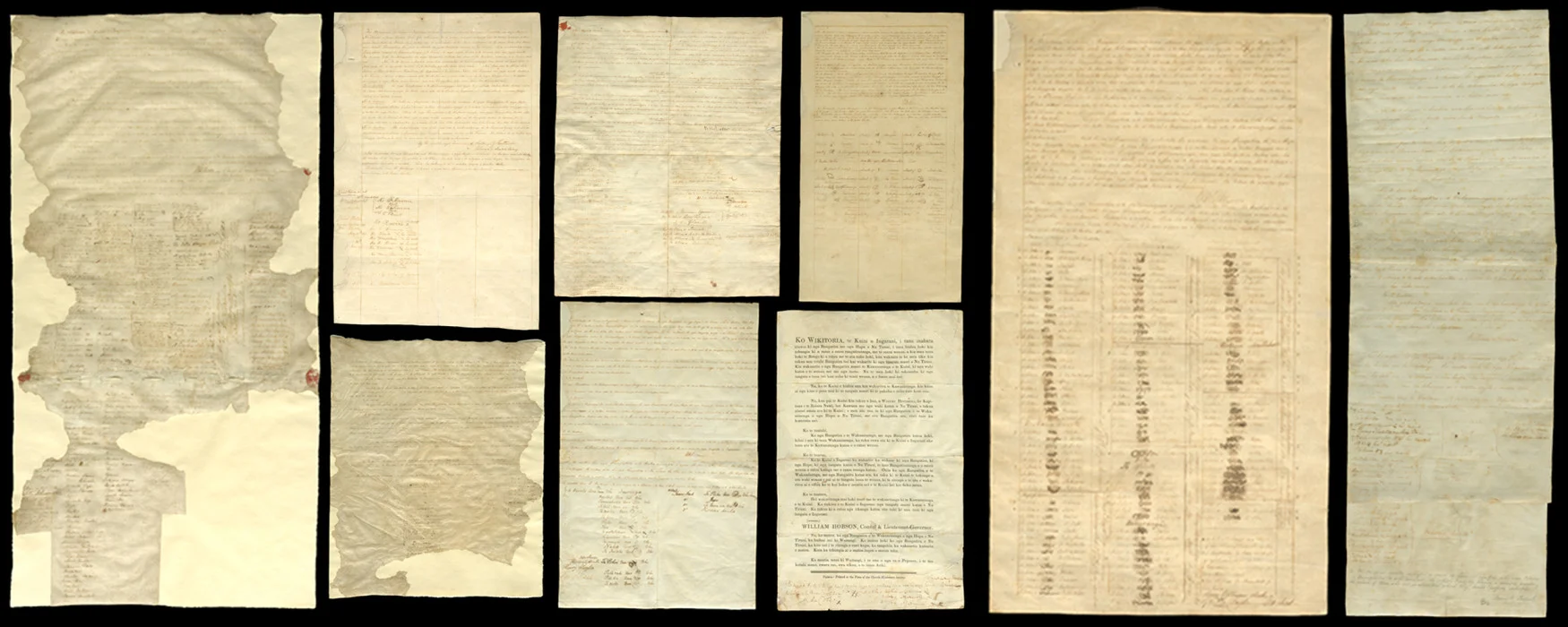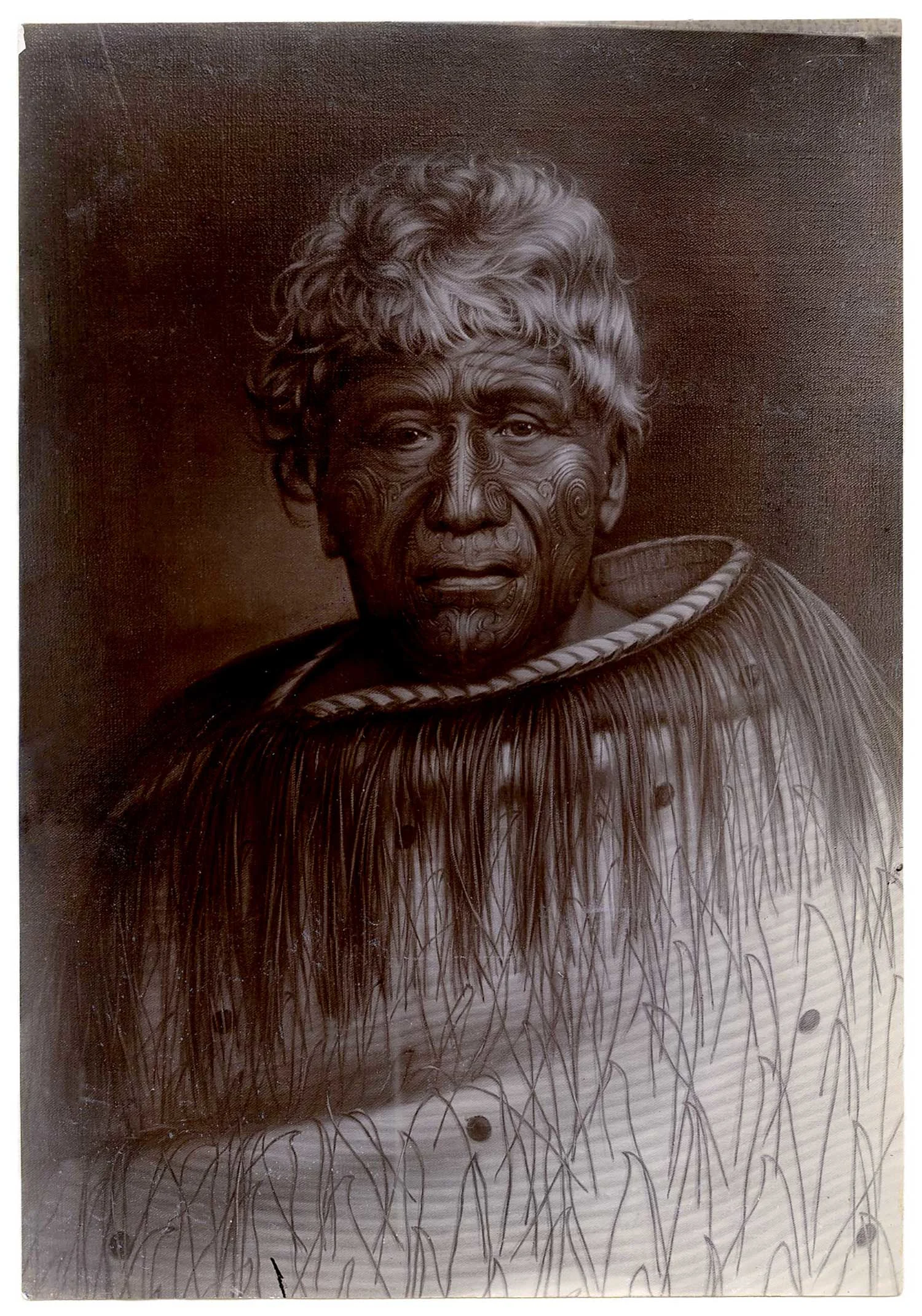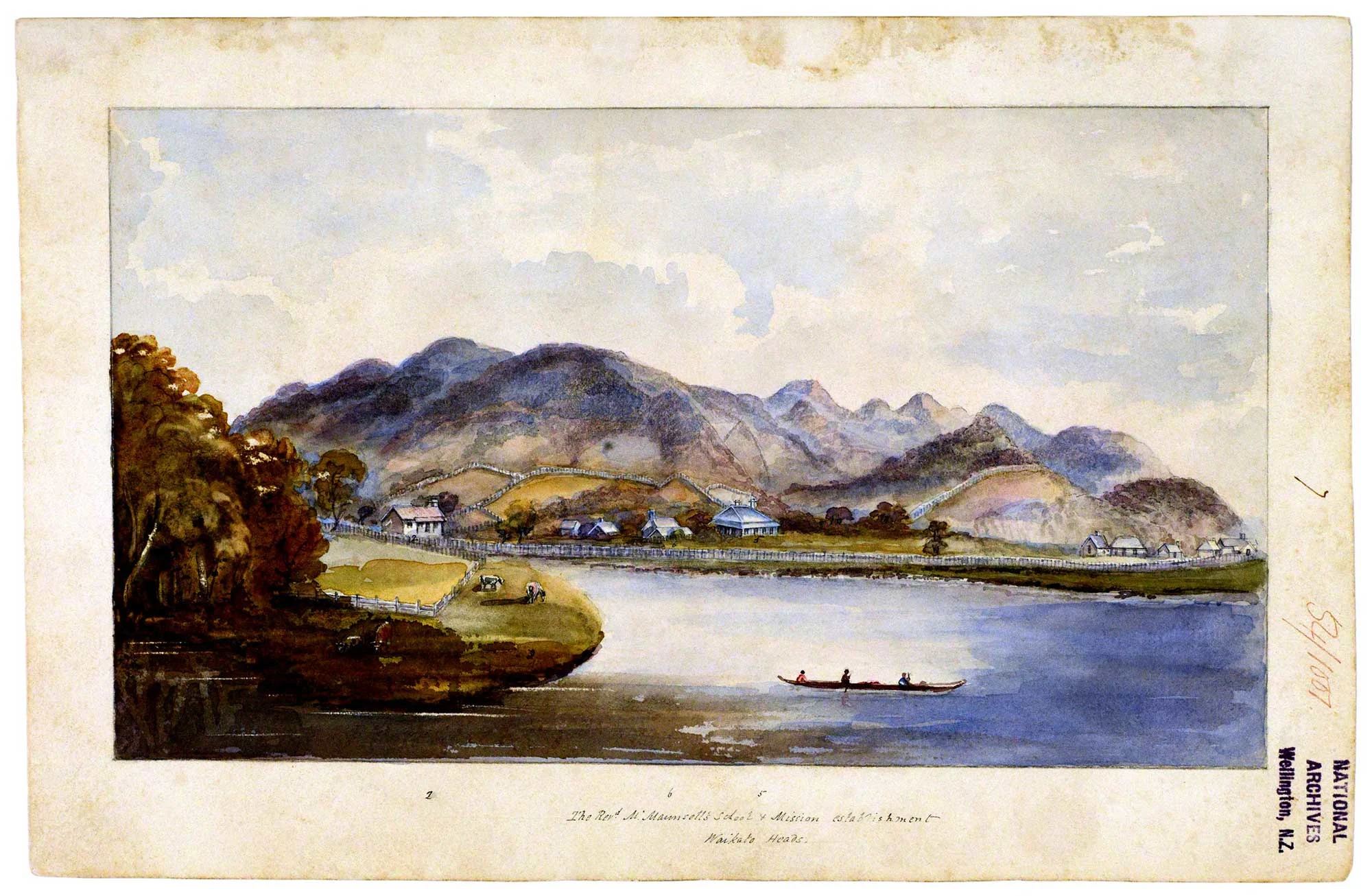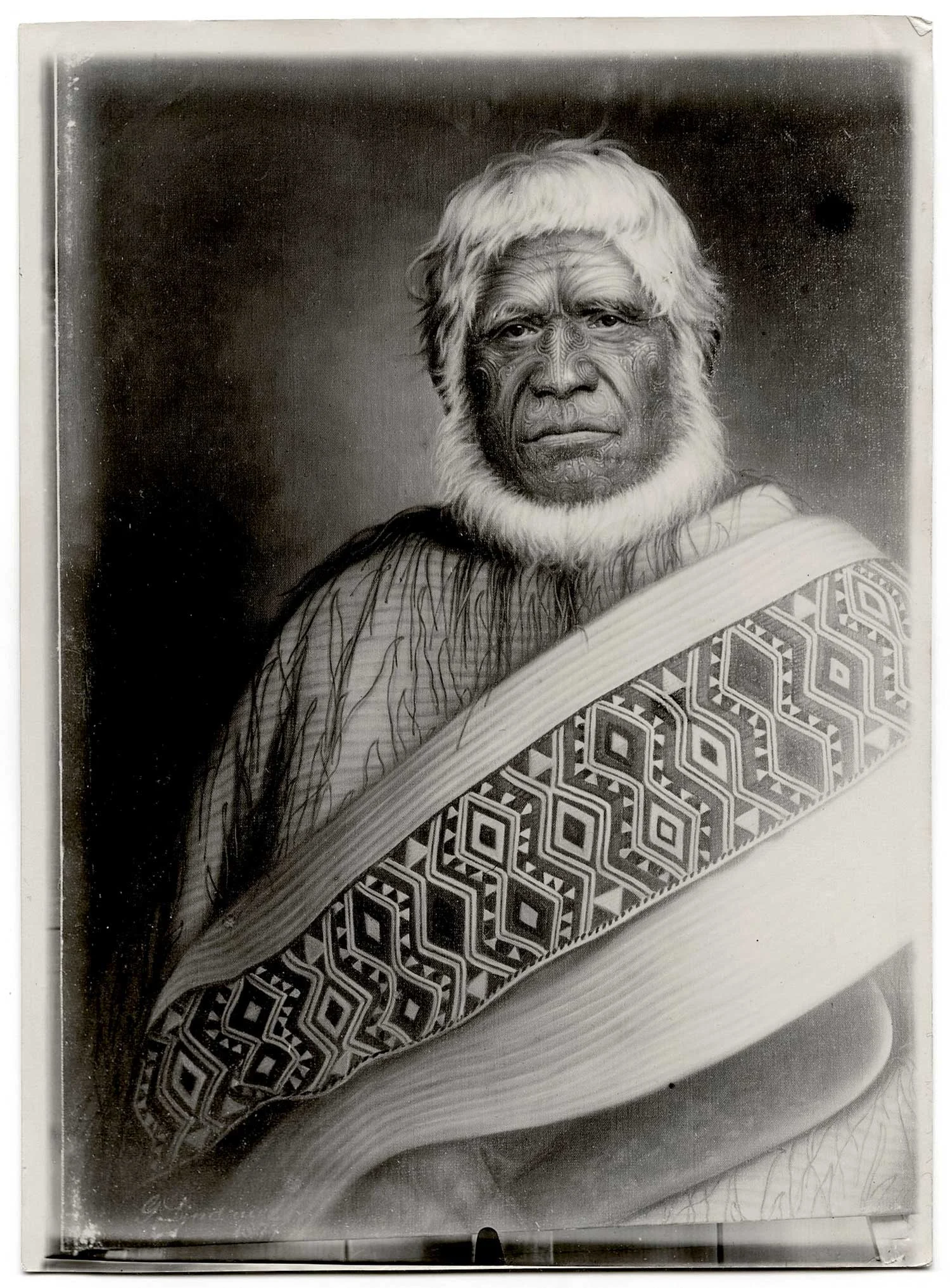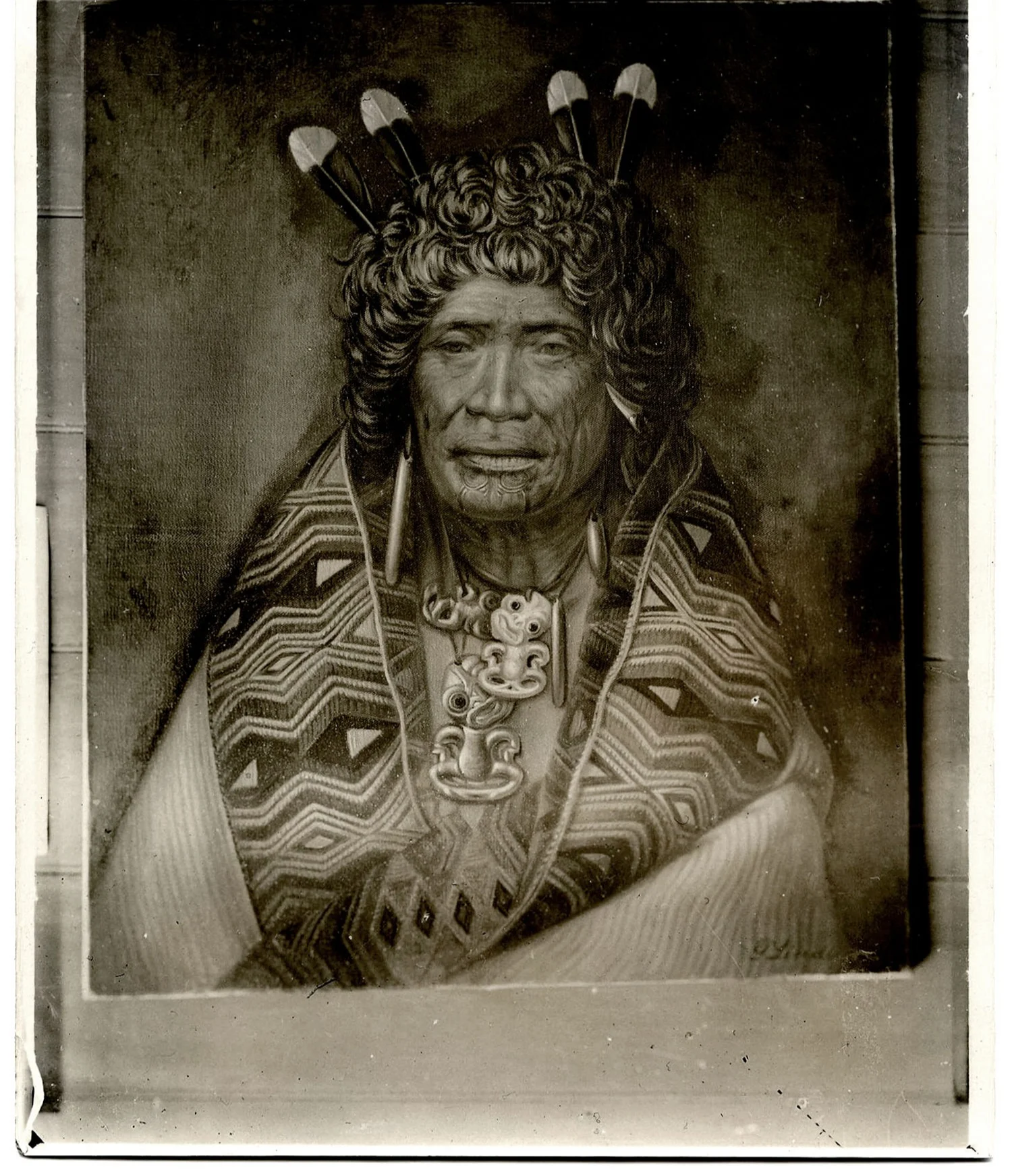Ngā tuhinga taketake o Te Tiriti o Waitangi
The Treaty of Waitangi original documents
Kei tēnei whārangi ka kite koe i ngā whakaahua me ngā pārongo ki ia whārangi o Te Tiriti o Waitangi. Ka kite hoki koe i ngā hononga ki ngā whakaahua arinui me ngā aratohu hoki.
On this page you’ll find images of and information about each sheet of the Treaty of Waitangi. You’ll also find links to high resolution images of each one, and guidelines on their reuse.
Tirohia tuihonotia ngā whārangi o Te Tiriti o Waitangi ki te ipurangi
View the sheets of the Treaty of Waitangi online
-
![Group of nine documents, seven on old paper and two on parchment with handwritten script and signatures]() Click to expandThe Treaty of Waitangi - Te Tiriti o Waitangi
Click to expandThe Treaty of Waitangi - Te Tiriti o Waitangi![Group of nine documents, seven on old paper and two on parchment with handwritten script and signatures]() Click to expandThe Treaty of Waitangi - Te Tiriti o Waitangi
Click to expandThe Treaty of Waitangi - Te Tiriti o Waitangi
Koinei ngā whārangi e 9 o Te Tiriti o Waitangi. E 7 kei runga pepa, e 2 he kiri kararehe. Hui katoa, he whakaaetanga tēnei i waenga i ngā māngai o te Karauna me ngā māngai o ngā iwi me ngā hapū Māori.
I tua atu i te tirotiro ā-tuihono ki konei, ka taea te tikiake ngā atahanga arinui o ia whārangi ki tā mātou whārangi Flickr e āta kite ai koe i ngā taipitopito. Whāia ā mātou aratohu kia tika ai tō whakamahi anō i ngā atahanga o te Tiriti.
These are the 9 sheets of te Tiriti o Waitangi. 7 are on paper and 2 are on parchment. Together they are an agreement between representatives of the British Crown and representatives of Māori iwi and hapū (tribes).
As well as viewing them online here, you can download high resolution images of each sheet on our Flickr page to see them in more detail. Follow our guidelines to ensure you reuse images of the Treaty appropriately.
Ngā aratohu o te whakamahi anō i ngā atahanga o Te Tiriti o Waitangi
Guidelines on reusing te Tiriti o Waitangi images
Me whai horopaki anō tō whakamahi i ngā atahanga o Te Tiriti o Waitangi, arā, kia mārama te pānui i ngā atahanga kia kore ai e pōhēhētia he tuhinga rerekē ēnei. Me whakaroha ngā atahanga kia kitea ai te āhua, arā ko Te Tiriti o Waitangi tonu. Ka taea te whakamahi i ētahi wāhanga o Te Tiriti o Waitangi hei whakarākeitanga, engari ki te pēnei, me kaua e whakauru i ngā waitohu Māori. Me kaua ētahi atu kuputuhi, atahanga rānei e pōkia ki runga o te atahanga o Te Tiriti o Waitangi, kaua rānei e taupoki i ētahi atu kuputuhi, atahanga rānei ki Te Tiriti. Me tika tō whakamahi i ngā atahanga o Te Tiriti o Waitangi, arā, kaua e whakamahia mō ngā whakatairanga, mō tētahi atu take mahi moni rānei.
Use images of the Treaty of Waitangi in context, such as where it is reasonably clear that the images cannot be mistaken for another document. Images need to be large enough to be recognised as te Tiriti o Waitangi. You can use portions of te Tiriti o Waitangi for stylistic effect, but any part used in this way should not include Māori signatories. Other text or images should not be used over an image of the Treaty of Waitangi, nor should the Treaty be used over other text or images. Always use images of te Tiriti o Waitangi appropriately, such as not for advertising endorsements or other commercial purposes.
Kimihia ētahi atu kōrero mō ia whārangi o Te Tiriti o Waitangi me āna waitohu.
Find out more about each sheet of te Tiriti o Waitangi and its signatures
Whārangi 1 – Te Tiriti o Waitangi | The Waitangi Sheet
Ko te whārangi o Waitangi o Te Tiriti o Waitangi i waitohua i te 1840 i ētahi wāhi rerekē puta noa i Aotearoa. Ko tēnei tuhinga he mea whakatauira mai i te ata o te 5 o Pēpuere e Minita Richard Taylor. Ko tēnei whārangi, pēnā i ētahi whārangi e 8 o te 9 whārangi, he mea tuhi ki te reo Māori.
Tirohia, tikiake rānei te whārangi o Waitangi o Te Tiriti o Waitangi, kia arinui te āhua
Sheet 1 – Te Tiriti o Waitangi | The Waitangi Sheet
The Waitangi Sheet of te Tiriti o Waitangi was signed in 1840 at various locations throughout Aotearoa New Zealand. The document itself was drawn up early on 5 February by the Reverend Richard Taylor. This sheet, like 8 of the 9 Tiriti sheets, is written in te reo Māori.
View or download the Waitangi Sheet of te Tiriti o Waitangi in high resolution
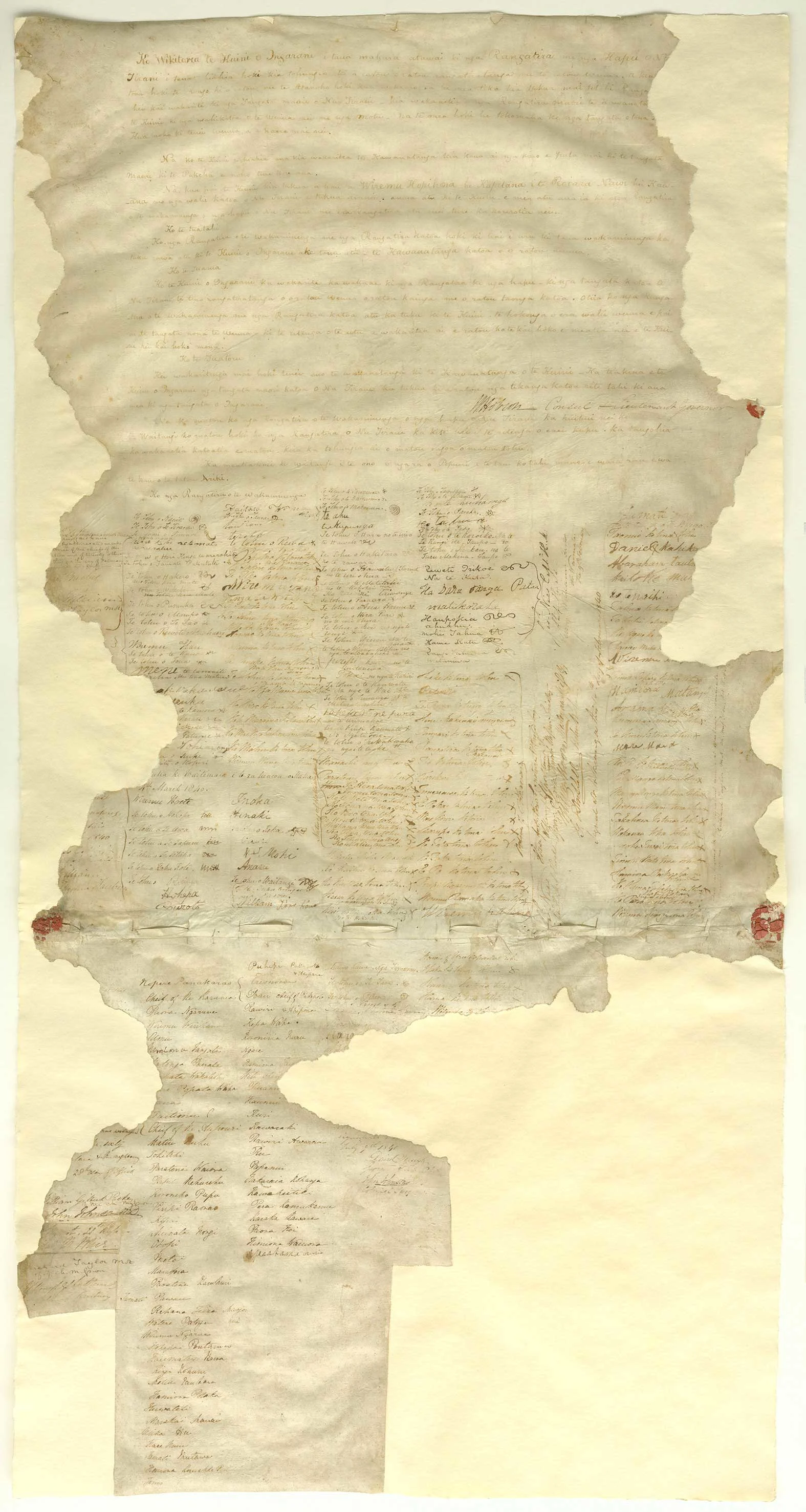
Ahakoa koinei te mea rongonui katoa, ehara Te Tiri o Waitangi i te whārangi kiri kararehe kotahi. Engari he huinga o ngā whārangi e 9 - 7 he pepa, e 2 he kiri kararehe.
Ki te titiro ki te whārangi o Waitangi, he uaua te whakatau ake tokohia ngā rangatira i waitohu i roto o Waitangi i te 6 o Pēpuere 1840. Engari ko te whakapae ake, kei waenga i te 42 me te 45 ngā rangatira i waitohu, tae atu ki ētahi wāhine pērā i a Takurua, rātou ko Te Marama, ko Ana Hamu. Neke atu i te 11 ngā rangatira i waitohu ake mā te tuhi i o rātou ingoa. Ko ētahi atu i whakamau tohu i te taha o tētahi rerenga tautohu, hei tauira, "Te tohu o Hori Kingi Warerahi (Te Wharerahi)".
Arā atu ētahi rangatira i waitohu i te 9 o Pēpuere ki Te Waimate. I Hokianga i te 12 o Pēpuere, he tokomaha ngā rangatira i waitohu ake, otirā he rīpeka noa iho te tohu. Koinei te wā i tāpirihia tētahi atu tīwae ki ngā tīwae e 3. Nō te 17 o Pēpuere - i te tānga o te tohu o Pōmare i runga ake o te ingoa o Hone Heke (te rangatira tuatahi ki te waitohu) - kua tīmata te taruweku haere o te whārangi.
Although it is the most well-known, the Treaty of Waitangi is not just this single sheet of parchment. It is a group of 9 sheets — 7 on paper and 2 on parchment.
Looking at the Waitangi Sheet, it’s difficult to determine exactly how many rangatira (chiefs) signed at Waitangi on 6 February 1840. But it is believed between 42 and 45 signed the sheet, including several women such as Takurua, Te Marama and Ana Hamu. At least 11 rangatira signed by writing their names. Others used marks beside an identifying phrase, for example, "Te tohu o Hori Kingi Warerahi" (the mark of Hori Kingi Te Wharerahi).
More rangatira signed on 9 February at Te Waimate. At Hokianga on 12 February, many of the chiefs who signed used simple crosses. An additional column was added to the original 3 at this time. By 17 February — when the mark of Pōmare was inserted above the name of Hōne Heke (the first chief to sign) — the sheet was already becoming cluttered.
-
![A portrait of a Māori leader a traditional Māori tattoo on his face, short white hair and wearing a cloak]() Click to expandHe peita o te rangatira a Pōmare o Ngāpuhi, Te Uri Karaka me Ngāti Manu nā Gottfried LindauerA painting of rangatira Pōmare of Ngāpuhi, Te Uri Karaka and Ngāti Manu by artist Gottfried Lindauer
Click to expandHe peita o te rangatira a Pōmare o Ngāpuhi, Te Uri Karaka me Ngāti Manu nā Gottfried LindauerA painting of rangatira Pōmare of Ngāpuhi, Te Uri Karaka and Ngāti Manu by artist Gottfried Lindauer![A portrait of a Māori leader a traditional Māori tattoo on his face, short white hair and wearing a cloak]() Click to expandHe peita o te rangatira a Pōmare o Ngāpuhi, Te Uri Karaka me Ngāti Manu nā Gottfried LindauerA painting of rangatira Pōmare of Ngāpuhi, Te Uri Karaka and Ngāti Manu by artist Gottfried Lindauer
Click to expandHe peita o te rangatira a Pōmare o Ngāpuhi, Te Uri Karaka me Ngāti Manu nā Gottfried LindauerA painting of rangatira Pōmare of Ngāpuhi, Te Uri Karaka and Ngāti Manu by artist Gottfried Lindauer
Nō te wā o te kohikohi i ētahi atu waitohu me ngā tohu i Te Waitematā i te 4 o Māehe, kua kore he wāhi wātea. Nā Kāpene Joseph Nias o te HMS Herald rāua ko George Cooper, te Kaitiaki Pūtea Koroni, i tāpiri i tētahi atu wāhanga kiri kararehe ki raro o te mea tuatahi. Ka kite tonu koe i te wāhi i tuituia ngā wāhanga e 2 i waenga i ngā hīri.
Ka whakamahia tēnei wāhanga i muri iho ki te kohikohi waitohu i Kaitaia, i Tāmaki me Kororāreka. E 240 katoa ngā waitohu kei runga i tēnei whārangi.
Ākona he kōrero anō mō Te Tiriti o Waitangi me tōna huanga ake.
By the time more signatures and marks were gathered at Waitematā on 4 March, there was no space left. Captain Joseph Nias of the HMS Herald and George Cooper, the Colonial Treasurer, had a second sheet of parchment added at the bottom. You can see where the 2 sheets were stitched together between the seals.
This sheet was later used to gather signatures at Kaitaia, Tāmaki (Auckland) and Russell. There are 240 signatures in total on this sheet.
Whārangi 2 – Te Tiriti ki Manukau-Kāwhia | The Manukau-Kāwhia Sheet
Sheet 2 – Te Tiriti ki Manukau-Kāwhia | The Manukau-Kāwhia Sheet

Ko te whārangi ki Manukau-Kāwhia anake te tārua e ora tonu ana me te waitohu a Willoughby Shortland, te Hēkeretari Koroni, kaua ko tā Rūtene-Kāwana William Hobson, otirā i pararaihātia i te 1 o Māehe. Kua tuhia ki te reo Māori. Koinei hoki te tārua whakamutunga i whakahokia ki te Hēkeretari Koroni i te 1841.
Tirohia, tikiake rānei i te whārangi ki Manukau-Kāwhia o Te Tiriti o Waitangi, kia arinui te āhua
I tukuna tuatahitia te whārangi o Manukau-Kāwhia ki a Kāpene William Symonds i te 13 o Maehe 1840. Nāna ngā waitohu o ngā rangatira i kohi huri noa i Manukau. I te 20 o Māehe, ka whakaritea e Symonds he hui ki Ōrua i te Kūrae o Manukau. Kāore he rangatira o Waikato i waitohu - arā ko Pōtatau Te Wherowhero tētahi. Engari anō a Te Kawau, a Te Tinana me Te Reweti o Ngāti Whātua, i waitohu rātou.
Nō te 3 o Āperira ka wehe a Symonds i Manukau ka haere whakatetonga ki Te Puaha o Waikato, ki reira tūtaki ai ki a Robert Maunsell. I muri i tana kite kua tutuki i ngā mihinare te rapu waitohu i ngā rangatira ki te whārangi o Waikato-Manukau, ka tukua e Symonds te whārangi o Manukau-Kāwhia ki ngā mihinare Wēteriana a James Wallis rāua ko John Whiteley i te 8 o Āperira. Nāna rāua i tono kia kohia ngā waitohu o ngā rangatira i Kāwhia me te rohe whakatetonga o Ngāti Maniapoto.
10 ngā waitohu i kohia e te tokorua rā i ngā rangatira o Kāwhia rohe, arā:
kotahi i te 28 Āperira
e 3 i te 21 o Mei
kotahi i te 25 o Mei
e 3 i te 15 o Pipiri
kotahi i te 27 o Ākuhata.
I kohia te waitohu whakamutunga i te 3 o Hepetema. Koinei hoki te waitohu whakamutunga o Te Tiriti o Waitangi i Aotearoa.
The Manukau-Kāwhia Sheet is the only surviving copy with the signature of Colonial Secretary Willoughby Shortland instead of Lieutenant-Governor William Hobson, who was paralysed by a stroke on 1 March. It is written in teo reo Māori. It was also the last copy to be returned to the Colonial Secretary, in 1841.
View or download the Manukau-Kāwhia Sheet of te Tiriti o Waitangi in high resolution
The Manukau-Kāwhia Sheet was first sent to Captain William Symonds on 13 March 1840. He gathered signatures from rangatira around the Manukau Harbour. On 20 March, Symonds organised a hui (meeting) at Orua Bay on the Manukau Peninsula. No Waikato rangatira signed — including Pōtatau Te Wherowhero. But Te Kawau, Te Tinana and Te Reweti of Ngāti Whātua did.
On 3 April, Symonds left Manukau Harbour and travelled south to Waikato Heads where he met Robert Maunsell. After seeing that the missionary had successfully gained signatures from rangatira on the Waikato-Manukau sheet, Symonds sent the Manukau-Kāwhia sheet to Wesleyan missionaries James Wallis and John Whiteley on 8 April. He asked them to secure the signatures of other rangatira in Kāwhia and in the area southward of Ngāti Maniapoto.
The pair gathered 10 more signatures from rangatira around Kāwhia, including:
one on 28 April
3 on 21 May
one on 25 May
3 on 15 June
one on 27 August.
The last signature was gathered on 3 September. This was also the final signing of te Tiriti o Waitangi in New Zealand.
Whārangi 3 – Te Tiriti ki Waikato-Manukau | The Waikato-Manukau Sheet
Sheet 3 – Te Tiriti ki Waikato-Manukau | The Waikato-Manukau Sheet
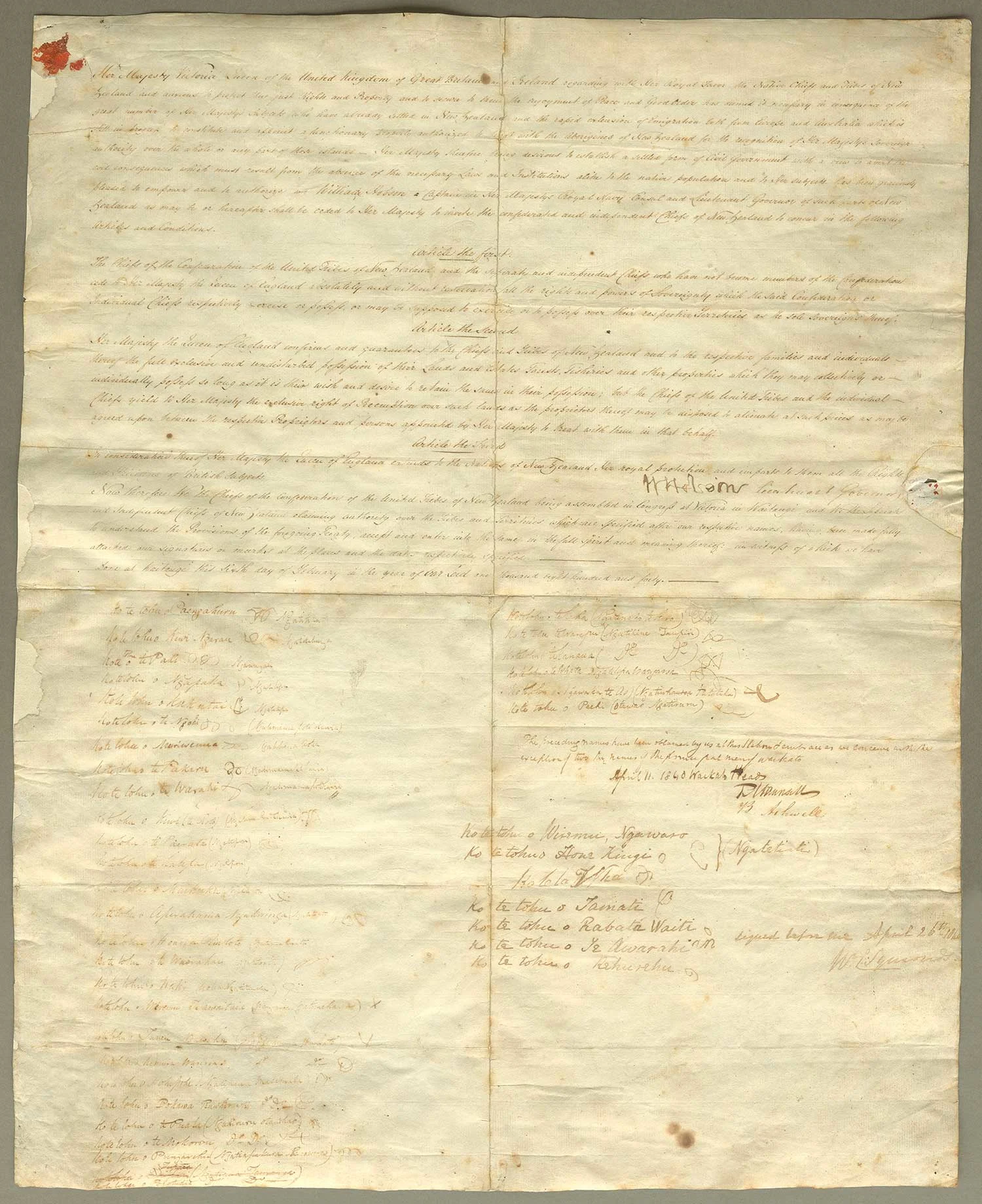
Ko te whārangi o Waikato-Manukau anake te tārua o Te Tiriti o Waitangi i tuhia ki te reo Ingarihi. He tau ngā tuhinga i runga pepa e mau ana i te tohu me te waitohu a Hobson. Nā tana ikura roro i te 1 o Māehe, he kotiti te waitohu. E whakapono ana ētahi tērā pea i waitohuhia e Hobson ki tana ringa mauī. E 39 ngā rangatira i waitohu i tēnei whārangi, tae atu ki tētahi wahine - Hoana Riutoto. Kāore i te mōhiotia te rā tūturu o ngā waitohu tuatahi.
Tirohia, tikiake rānei te Whārangi o Waikato-Manukau o Te Tiriti o Waitangi, kia arinui te āhua
I whiwhi a Maunsell - i te Pūaha o Waikato tōna whare mīhana - i te whārangi i te hiku o te Māehe, i te pane rānei o Āperira 1840. I taua wā hoki, tata ki te 1,500 ngā Māori i huihui ki te whare mīhana mō te hui. Ka whai hua ia i te tūnga o taua hui, otirā 32 ngā waitohu o ngā rangatira i kohia e ia. Ko te nuinga nō te taha whakararo o Waikato, otirā ko ētahi nō Ngāruawāhia, piki whakarunga hoki i te awa. Ko te tuhinga i runga i te whārangi e kī ana, he mea taunaki tēnei e tētahi kaiwhakaatu i te 11 o Aperira.
The Waikato-Manukau Sheet is the only copy of te Tiriti o Waitangi written in English. The text is neatly written on paper bearing Hobson’s seal and signature. Because of his stroke on 1 March, the signature is very shaky. Some believe Hobson may have signed with his left hand. 39 rangatira signed this sheet, including at least one woman — Hoana Riutoto. The exact date of the first signings is unknown.
View or download the Waikato-Manukau Sheet of te Tiriti o Waitangi in high resolution
Maunsell — whose mission station was near the mouth of the Waikato River — received the sheet in late March or early April 1840. At the same time, around 1,500 Māori gathered at the mission for a hui. Taking advantage of the meeting, he secured the signatures of 32 rangatira. Most were from the lower Waikato region, with some from Ngāruawāhia and further upstream. The sheet notes that it was witnessed on 11 April.
-
![A watercolour painting houses sitting upon the waterfront, with large mountains behind. A waka can be seen floating in the water.]() Click to expandTe kāinga me te mīhana o Robert MaunsellMissionary Robert Maunsell’s home and mission station
Click to expandTe kāinga me te mīhana o Robert MaunsellMissionary Robert Maunsell’s home and mission station![A watercolour painting houses sitting upon the waterfront, with large mountains behind. A waka can be seen floating in the water.]() Click to expandTe kāinga me te mīhana o Robert MaunsellMissionary Robert Maunsell’s home and mission station
Click to expandTe kāinga me te mīhana o Robert MaunsellMissionary Robert Maunsell’s home and mission station
Nō te taenga o Kāpene Symonds ki te whare mīhana, ka kite ia kua oti kē i a Maunsell te kohikohi i ētahi waitohu. Kātahi ia ka kawe i te whārangi ki Manukau, ka tāpirihia ngā waitohu e 7 i te 26 o Āperira - i Te Āwhitu pea. I konei a Te Wherowhero me ētahi atu rangatira, engari kāore i waitohu, tērā pea nā te kore whaimana o te tūtakitanga, pērā i te kaupapa nui i tū ki Waitangi.
Ka kapohia e Maunsell ngā ingoa o ngā iwi, hapū rānei o te nuinga o ngā rangatira. He wā anō ka tuhia e ia tō rātou wāhi noho, engari he wā anō kāore i pēnā.
When Captain Symonds arrived at the mission, he found that Maunsell had already gathered many signatures. He travelled with the sheet to Manukau Harbour, where 7 names were added on 26 April — likely at Āwhitu. Te Wherowhero and several others were present but would not sign, possibly because the occasion lacked the dignity of the events at Waitangi.
Maunsell recorded the iwi or hapū of most of the rangatira. Sometimes he noted their location, although this often changed.
Whārangi 4 – He mea i tāia | The Printed Sheet
Sheet 4 – He mea i tāia | The Printed Sheet
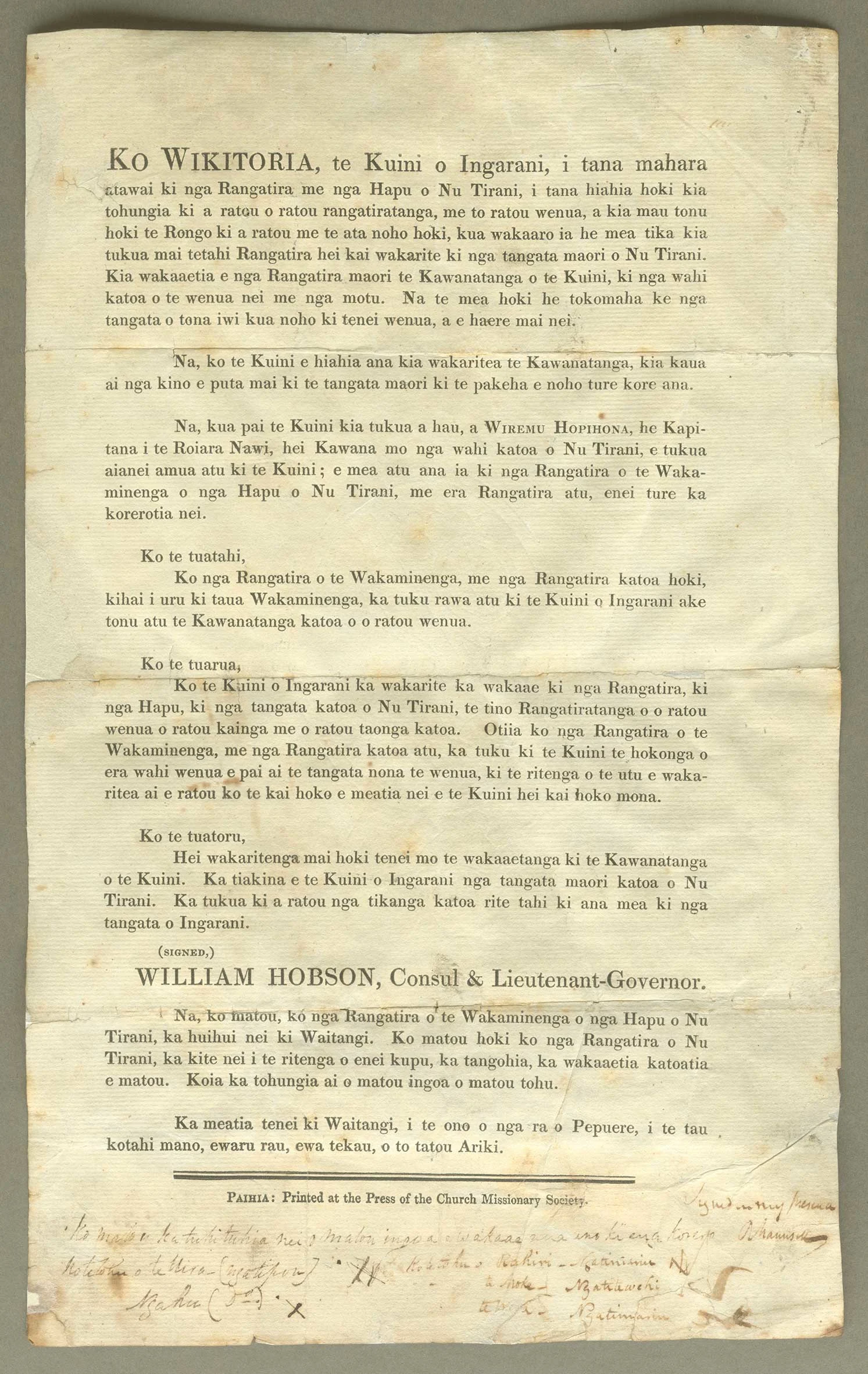
E mōhiotia ana tēnei ko te Whārangi i Tāia, ko te whārangi o Waikato te tānga anake e toe tonu ana o Te Tiriti o Waitangi e mau waitohu ana. Ko ētahi atu o ngā whārangi he mea tuhi ki te ringa. He kupu whakamārama hoki kua tuhia ki tēnei whārangi: "Ko mātou ka tuhituhia nei ō mātou ingoa e whakaae ana ki ēnā kōrero”. Ko te whakamārama o tēnei "he tohu whakaae ō mātou ingoa ki ngā kōrero i puta", "ka waitohu mātou i ō mātou ingoa ki te tautoko i ēnei wāhanga rānei.
Tirohia, tikiake rānei te Whārangi i Tāia o Te Tiriti o Waitangi, kia arinui te āhua
Ko te Whārangi i Tāia tētahi o ngā tārua e 200 o te putanga reo Māori i tāia i Paihia i te 17 o Pēpuere 1840 e William Colenso, te ringatā a te Rōpū Hāhi Mihinare. Kāore i te mōhiotia te rā o ngā waitohu, engari ko te āhua nei he āpitihanga tēnei ki te whārangi o Waikato-Maniapoto, otirā he reo Ingarihi tērā. I whiwhi a Maunsell i te whārangi, ā, ka waitohua e ia i te hiku o Māehe, te pane o Āperira rānei 1840.
I noho hoki a Maunsell hei kaiwhakaatu o ngā ingoa e 5 katoa o te Whārangi i Tāia. Tērā pea ko ngā rangatira nei - nō Ngāti Pou o te Awa o Waikato me Ngāti Te Wehi o Whāingaroa - i te peka atu ki te whare mīhana o Maunsell.
Known as the Printed Sheet, the Waikato copy is the only surviving printed copy of te Tiriti o Waitangi with signatures. The other sheets are written in longhand. There is an explanatory note handwritten on this sheet: “Ko mātou ka tuhituhia nei ō mātou ingoa e whakaae ana ki ēnā kōrero”. This roughly means “we sign our names in agreement of these discussions” or “we sign our names in agreement of these articles”.
View or download the Printed Sheet of te Tiriti o Waitangi in high resolution
The Printed Sheet is one of 200 copies of the Māori text printed in Paihia on 17 February 1840 by Church Missionary Society (CMS) printer, William Colenso. The dates of its signatures are unknown, but it is most likely an adjunct to the Waikato-Manukau sheet, which is in English. Maunsell received and signed that sheet in late March or early April 1840.
Maunsell also witnessed all 5 names on the Printed Sheet. The rangatira — from Ngāti Pou on the Waikato River and Ngāti Te Wehi at Raglan — may have been visiting Maunsell's mission station.
Whārangi 5 – Te Tiriti ki Tauranga | The Tauranga Sheet
Sheet 5 – Te Tiriti ki Tauranga | The Tauranga Sheet
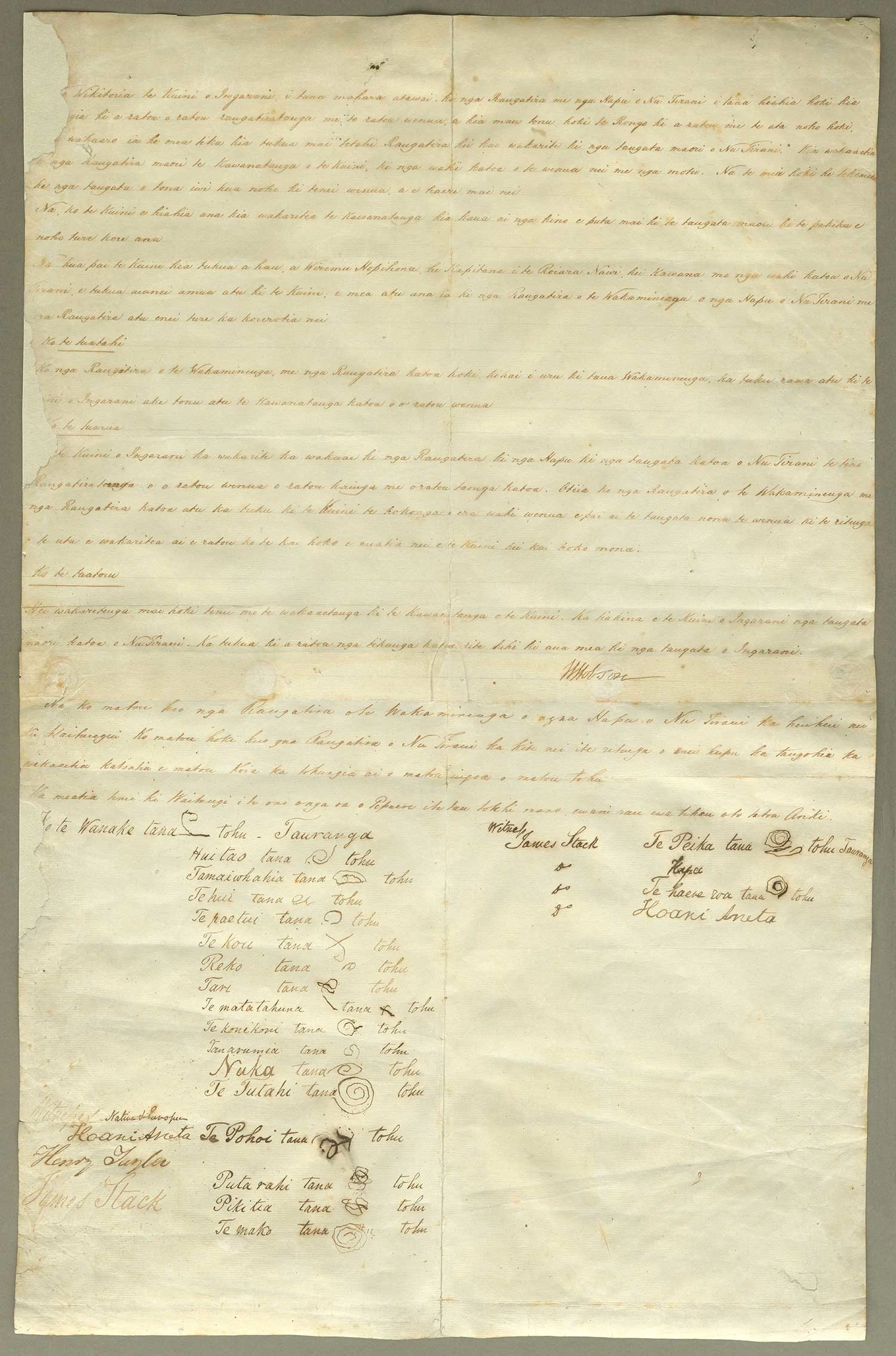
I muri i te pānga o Hobson ki te mate ikura roro, i whakamanata ētahi miningare ki te tū hei kaiwhiriwhiri ōkawa ki te kohi waitohu ki Te Tiriti o Waitangi. Kia tae ki te 1 o Āperira 1840, e rua ngā tārua o te Tiriti i tae ki a Alfred Brown - te mihinare CMS i Tauranga. Ko tētahi o ēnei te whārangi o Tauranga. He mea tuhi te whārangi nei ki te reo Māori.
Tirohia, tikiake rānei te Whārangi o Tauranga o Te Tiriti o Waitangi, kia arinui te āhua
21 ngā waitohu o ngā rangatira i kohia e Brown i te takiwā o te 10 o Āperira. Ko te nuinga nō Ngāi Te Rangi, hāunga a Te Kou-o-Rehua o Ngāti Pūkenga. Engari kīhai rawa a Tupaea, tētahi rangatira mana nui o Ngāi Te Rangi, me ētahi atu rangatira i waitohu.
I tae ake a Meiha Thomas Bunbury, te tuarua a Hobson, ki Tauranga i te 11 o Mei ki te tiro i te āhua o te kohi a Brown i ngā waitohu. Kātahi ka whakahauhia a te mihinare nei a James Stack e Bunbury ki te tā i ētahi atu tārua e 2 o Te Tiriti o Waitangi.
I tukuna tētahi tārua ki Rotorua me Taupō, engari kīhai rawa a Te Arawa me Ngāti Tūwharetoa i whakatau ki te waitohu. Kua ngaro tēnei tārua. Ko te tārua tuarua ko te whārangi o Te Moana o Toi (Fedarb). Nō te 23 o Mei 1840 te Whārangi o Tauranga i whakahokia ai ki a Hobson.
After Hobson's stroke, various missionaries were authorised to act as official negotiators to gather signatures on the Treaty of Waitangi. By 1 April 1840, Alfred Brown — the CMS missionary in Tauranga — had received 2 copies of te Tiriti. One of these is the Tauranga sheet. This sheet is written in te reo Māori.
View or download the Tauranga Sheet of te Tiriti o Waitangi in high resolution
Brown gathered signatures from 21 rangatira on or around 10 April. All were from Ngāi Te Rangi, except for Te Kou-o-Rehua of Ngati Pukenga. But Tupaea, a key Ngāi Te Rangi rangatira, and others refused to sign.
Major Thomas Bunbury, Hobson’s second in command, arrived at Tauranga on 11 May to see how Brown was progressing. Bunbury then had the missionary James Stack produce 2 more copies of te Tiriti o Waitangi.
One copy was sent inland to Rotorua and Taupō, where Te Arawa and Ngāti Tūwharetoa refused to sign. This copy has since been lost. The second copy was the Bay of Plenty (Fedarb) Sheet. The Tauranga Sheet was finally returned to Hobson on 23 May 1840.
Sheet 6 – Te Tiriti ki Te Moana o Toi Huatahi | The Bay of Plenty (Fedarb) Sheet
Sheet 6 – Te Tiriti ki Te Moana o Toi Huatahi | The Bay of Plenty (Fedarb) Sheet
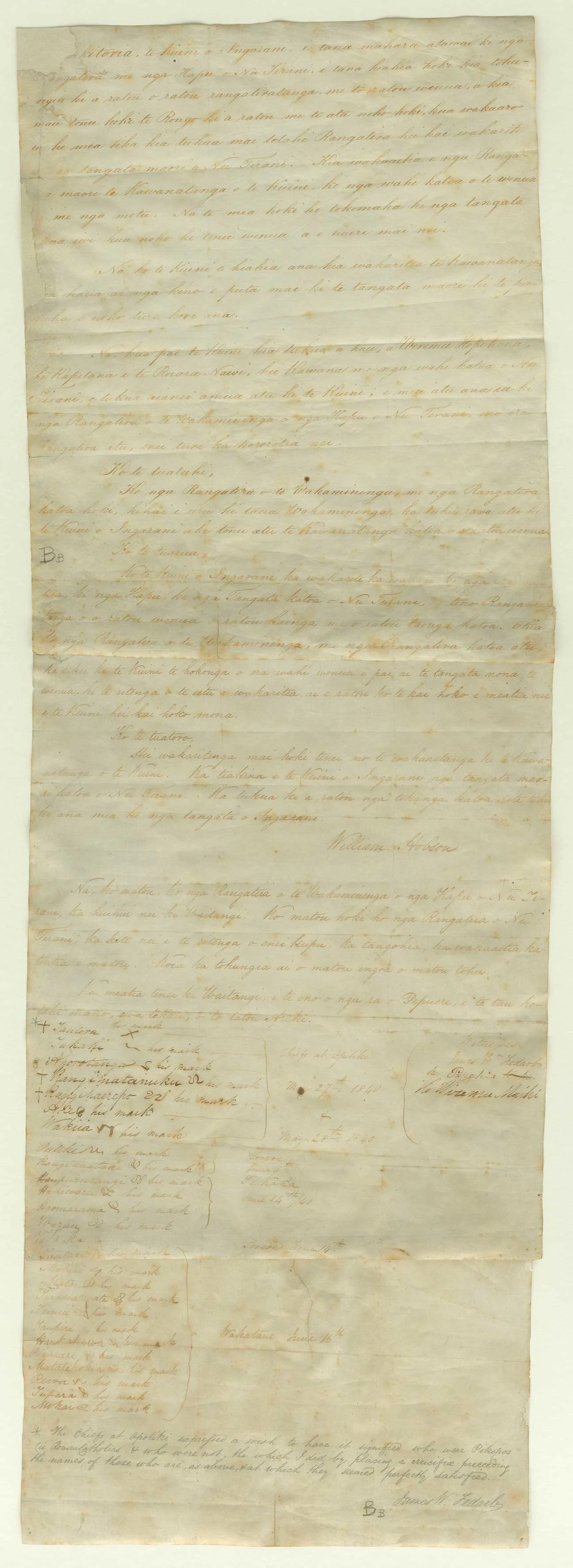
Ko te Whārangi o Te Moana o Toi tētahi o ngā tārua e 2 o Te Tiriti o Waitangi i tuhituhia e Stack - nā Bunbury hoki te whakahau. Ka tukua tēnei whārangi ki a James Fedarb, he kaihokohoko, e 23 tau te pakeke. Ko te tikanga ka utua a Fedarb mō ia waitohu ka kohia e ia, engari i te mutunga iho, kāore i ia i utua. He mea tuhi te whārangi nei ki te reo Māori.
Tiro, tikiake rānei i te Whārangi o Te Moana o Toi (Fedarb), kia arinui te āhua
Ka wehe a Fedarb i Tauranga mā runga i te Mercury i te 22 o Mei, ka tere haere i Te Moana o Toi. E 26 ngā waitohu i kohia e ia i tēnei haerenga, otirā arā noa atu āna kaupapa tauhokohoko.
I Ōpōtiki i te 27 me te 28 o Mei, tokowhitu ngā rangatira o Te Whakatōhea, he Katorika, he Mihinare hoki, i waitohu ake. Nā runga i tō rātou tono, ka tāpirihia he rīpeka i te taha o ō rātou ingoa hei whakaatu i tō rātou whakapono. Arā atu anō ngā rangatira i waitohu ake:
Tokorua i Tōrere i te 11 o Hune
Kotahi i te 14 o Hune - i waho pea i te moana
Tokowhā i Te Kaha i te 14 o Hune
Tekau mā rua i Whakatāne i te 16 o Hune.
I tōna taenga ki Te Pēwhairangi i te 19 o Hune, ka tukua e Fedarb he tārua ki a Colenso, hei tuku ki a Hobson. Kāore tētahi i kōrero ake mō te waitohu, otirā he mea horihori kē. Ko te waitohu hoki a Hobson, ko te 'W Hobson' kāore ia i whakauru i te taitara o te kāwana. Engari i te wā i tāruatia e Stack i Tauranga, ka tuhia e ia 'William Hobson' ki tōna ringa ake.
The Bay of Plenty (Fedarb) Sheet is one of 2 copies of te Tiriti o Waitangi produced by Stack — as requested by Bunbury. The sheet was given to the 23-year-old trader James Fedarb. Fedarb was supposed to receive compensation for each signature he gathered, but in the end, he was never paid. This sheet is written in te reo Māori.
View or download the Bay of Plenty (Fedarb) Sheet in high resolution
Fedarb left Tauranga aboard the Mercury on 22 May, sailing around the Bay of Plenty. He gathered 26 signatures during his trip, which he mixed with his own trading interests.
At Ōpōtiki on 27 and 28 May, 7 Whakatōhea rangatira of Catholic and Anglican affiliation signed. At their request a cross was added beside their names to show their religions. Additional rangatira signed, including:
2 at Tōrere on 11 June
one on 14 June — possibly offshore
4 at Te Kaha on 14 June
12 at Whakatāne on 16 June.
When he arrived in the Bay of Islands on 19 June, Fedarb gave the copy to Colenso to pass on to Hobson. No one commented that the signature on the sheet was technically forged. Hobson always signed as 'W Hobson' with no governor's title. But when Stack made the copy at Tauranga, he wrote 'William Hobson' in his own hand.
Whārangi 7 – Te Tiriti ki te Manuao Herara | The Herald-Bunbury Sheet
Sheet 7 – Te Tiriti ki te Manuao Herara | The Herald-Bunbury Sheet

Tērā pea he mea tārua te whārangi o Herald-Bunbury e te kaiwhakamāori e Henry Tacy Kemp. Kei runga kiri kararehe, ā, e mau ana i te waitohu a Hobson. Nō ngā tau i muri ake, ka kainga tētahi wāhanga e te kiore. Pērā ki te 8 o ngā whārangi e 9, he reo Māori tēnei whārangi.
Tirohia, tikiake rānei te Whārangi o Herald-Bunbury o Te Tiriti o Waitangi, kia arinui te āhua
I te rua marama i te 1840, ka tere haere a Bunbury i Aotearoa ki te kohikohi waitohu ki Te Tiriti o Waitangi. Ko tana hoa haere ko Edward Williams - te tama a te mihinare nei a Henry Williams. Ko te matua me te tama nei ngā kaiwhakamāori e rua o Te Tiriti o Waitangi taketake, mai i te reo Ingarihi ki te reo Māori.
I tohutohutia a Bunbury rāua ko Williams ki te whakaoti haere i ngā whiriwhiri kōrero i ngā wāhi o Te Ika-a-Māui kāore anō kia kapi i ētahi atu. Me te tohutohu anō hoki ki te rapu whakaaetanga mai i Te Waipounamu.
Ka wehe te tokorua nei i Te Pēwhairangi i te 28 o Āperira i runga i te HMS Herald, i raro i te hautūtanga o Kāpene Nias. He 27 katoa ngā waitohu i kohia e rāua i runga i ō rāua hāereere.
Ko ētahi rangatira i waitohu i te Tiriti i te 4 o Mei ki Hauraki. Engari i te hiahia ētahi atu kia wānangatia te kaupapa i te tuatahi nā reira kīhai i waitohu.
I te 5 o Mei, ka ngana anō a Bunbury rātou ko Williams, ko James Preece te mihinare CMS, engari auare ake. Heoi nō te 7 o Mei, e 2 ngā rangatira i waitohu ake i te taunga o te kaipuke ki waho o Ahuahu.
Ko ētahi atu waitohu kei runga i te Whārangi o Herald-Bunbury o Te Tiriti o Waitangi:
E 2 i Ōnuku i te 30 o Mei
E 3 i Ruapuke (he motu kei Te Ara a Kewa) i te 10 o Hune
E 2 i Ōtākou i te 13 o Hune
Me tētahi atu waitohu i kapohia ake i Te Koko a Kupe i te 17 o Hune. Ko te whakahau hoki a Nohorua, he rangatira o Ngāti Toa, kia noho ko tana hunaonga a Joseph Thoms hei kaiwhakaatu. E ai ki a Nohorua, ki te ngaro ngā whenua o āna mokopuna, ka tau tētahi wāhanga o te heitara ki tō rātou matua.
I te 17 o Hune, ka kauhautia e Bunbury te tino rangatiratanga i runga ake o Te Waipounamu. Kātahi a ia ka tere ki Kapiti, kei te tai hauāuru o Te Ika-a-Māui. I waho ake o te motu o Mana, ka rokohina e ia a Te Rauparaha, me te whakahau anō kia waitohu ia. Ko te whakautu a Te Rauparaha, kua waitohu kē ia i te whārangi o Raukawa Moana, engari ka waitohu anō ia i tā Bunbury i te 19 o Hune. Kātahi ia ka tū ki te awa o Tukituki i Te Matau-a-Māui. I konei, ka waitohua e Te Hāpuku, te rangatira o Ngāti Te Whatu-i-āpiti. I te 2 o Hūrae, ka ū anō a Bunbury ki Te Pēwhairangi.
The Herald-Bunbury copy was likely made by translator Henry Tacy Kemp. It is on parchment and bears Hobson's signature. In later years, it suffered severe damage from an encounter with rats or mice. Like 8 of the 9 sheets, this sheet is in te reo Māori.
View or download the Herald-Bunbury Sheet of te Tiriti o Waitangi in high resolution
Over 2 months in 1840, Bunbury sailed around Aotearoa gathering signatures on te Tiriti o Waitangi. He was joined by Edward Williams — the son of missionary Henry Williams. The father and son were the translators of the original Treaty of Waitangi from English into te reo Māori.
Bunbury and Williams were instructed to complete negotiations in areas of the North Island that had not been covered yet. They were also told to secure agreement in the South Island.
The pair left the Bay of Islands on April 28 aboard the HMS Herald, under the command of Captain Nias. They gathered a total of 27 signatures during their travels.
Some chiefs signed te Tiriti on 4 May at Coromandel Harbour. But others felt that more time should be allowed for consultation, so they refused.
On 5 May, Bunbury, Williams and CMS missionary James Preece unsuccessfully tried again. But on 7 May, 2 rangatira signed when the ship anchored off the Mercury Islands.
Other signatures on the Herald-Bunbury Sheet of te Tiriti o Waitangi include:
2 at Ōnuku on 30 May
3 at Ruapuke (an island in Foveaux Strait) on 10 June
2 at Otago Harbour on 13 June.
Another signing occurred in Cloudy Bay on 17 June. Ngāti Toa chief Nohorua insisted his signature be witnessed by his son-in-law, whaler Joseph Thoms. According to Nohorua, should his grandchildren lose their land their father might share the blame.
On 17 June, Bunbury proclaimed sovereignty over the South Island. He then sailed for Kāpiti off the west coast of the North Island. Off Mana Island he found Te Rauparaha and insisted that he sign. Te Rauparaha assured Bunbury that he had already signed the Cook Strait sheet, but also signed Bunbury's copy on 19 June. He then briefly stopped at the Tukituki River in Hawke's Bay. Here, rangatira Te Hapuku of Ngāti Te Whatu-i-āpiti signed. On July 2, Bunbury arrived back at the Bay of Islands.
-
![A portrait of a Māori leader with white hair and a beard, wrapped in a cloak, a traditional Māori tattoo on his face.]() Click to expandHe pikitia o Te Hāpuku o Ngāti Te Whatu-i-Āpiti, nō Te Matau-a-Māui, nā Gottfried LindauerA painting of Te Hapuku of Ngāti Te Whatu-i-āpiti, Hawkes Bay by artist Gottfried Lindauer
Click to expandHe pikitia o Te Hāpuku o Ngāti Te Whatu-i-Āpiti, nō Te Matau-a-Māui, nā Gottfried LindauerA painting of Te Hapuku of Ngāti Te Whatu-i-āpiti, Hawkes Bay by artist Gottfried Lindauer![A portrait of a Māori leader with white hair and a beard, wrapped in a cloak, a traditional Māori tattoo on his face.]() Click to expandHe pikitia o Te Hāpuku o Ngāti Te Whatu-i-Āpiti, nō Te Matau-a-Māui, nā Gottfried LindauerA painting of Te Hapuku of Ngāti Te Whatu-i-āpiti, Hawkes Bay by artist Gottfried Lindauer
Click to expandHe pikitia o Te Hāpuku o Ngāti Te Whatu-i-Āpiti, nō Te Matau-a-Māui, nā Gottfried LindauerA painting of Te Hapuku of Ngāti Te Whatu-i-āpiti, Hawkes Bay by artist Gottfried Lindauer
Whārangi 8 – Te Tiriti ki Raukawa Moana | The Cook Strait (Henry Williams) Sheet
Sheet 8 – Te Tiriti ki Raukawa Moana | The Cook Strait (Henry Williams) Sheet

He tino rerekē te whārangi o Raukawa Moana ki ērā atu o ngā whārangi o Te Tiriti o Waitangi. Ko te whakatakotoranga o tēnei, e rua ngā taitapa, e toru ngā tīwae o ngā tuhinga me ngā tohu e tohu ana i ngā rangatira nui o ngā iwi me ētahi atu tohu whakamārama. Ko te waitohu a Hobson, he tūturu, engari he āhua kotiti. He mea tuhi te whārangi nei ki te reo Māori.
Tirohia, tikiake rānei te Whārangi o Raukawa Moana o Te Tiriti o Waitangi, kia arinui te āhua
Ko ētahi atu ingoa ōna ko te whārangi o Raukawa Moana, ā, ko te whārangi a Henry Williams hoki, koinei tētahi o ngā whārangi e 2 i kawea haere e Henry Williams i tana wehenga i Te Pēwhairangi mā runga i te Ariel i te 2 o Āperira 1840. Ko tētahi atu, te Whārangi o Te Tai Rāwhiti, he mea tuku ki tana teina a William Williams i Tūranga i te 8 o Āperira.
Ka tae a Williams ki Pōneke i te puku o Āperira, engari kāore he rangatira i waitohu ake mō te 10 rā. Kātahi ka tū tētahi hui i runga i te kaipuke o Ariel i te 29 o Āperira. I konei, 34 ngā rangatira i waitohu ake.
Arā atu anō i ētahi i waitohu i Tōtara-nui i te 4 me te 5 o Mei, me Rangitoto i te 11 o Mei. Kātahi a Williams ka haere mā Te Tai Hauāuru me te kapo ake i ētahi atu waitohu o ngā rangatira i:
Ōtaki
Waikanae
Manawatū
Whanganui
Motu Ngārara (he motu iti i waho o Kāpiti).
Ko te hiahia o Williams ko te kawe i te whārangi nei ki Ōtākou engari i tana hokinga ki Kāpiti i te pane o Hune, ka rongo ia kua tae kē a Bunbury me tāna ake whārangi (Herald) ki te tonga. Kātahi a Williams ka hoki ki Te Pēwhairangi me āna waitohu 132.
He ingoa wāhine kei runga i te whārangi o Raukawa Moana - ko Kahe Te Rau-o-te-rangi, ko Te Rangitopeora, ko Rere-o-maki hoki. Ko te āhua nei arā atu anō ngā wāhine i waitohu, hei tauira, a, Pakewa rāua ko Kehu - te ingoa i mōhiotia ai te whaea o WIremu Kingi Te Rangitake.
Ākona he kōrero mō ngā wāhine i waitohu i Te Tiriti o Waitangi
The Cook Strait sheet is quite different from the other sheets of te Tiriti o Waitangi. Carefully set out within a double border, the text is in 3 neat columns with marks indicating the principal chiefs of different tribes and other explanatory symbols. The signature of Hobson is genuine but shaky. This sheet is written in te reo Māori.
View or download the Cook Strait (Henry Williams) Sheet of te Tiriti o Waitangi in high resolution
Also known as the Raukawa Moana sheet and the Henry Williams sheet, the Cook Strait sheet is one of 2 sheets Williams took when he left the Bay of Islands aboard the Ariel on 2 April 1840. The other one, the East Coast Sheet, was given to his brother William Williams at Tūranga (Gisborne) on 8 April.
Williams arrived at Port Nicholson (Wellington) in mid-April, but for 10 days no rangatira signed. A meeting was finally arranged onboard the Ariel for 29 April. Here, 34 rangatira signed.
More signed at Queen Charlotte Sound on 4 and 5 May, and Rangitoto (D’Urville Island) on 11 May. Williams then travelled along the west coast of the North Island and received the signatures of several rangatira at:
Ōtaki
Waikanae
Manawatū
Whanganui
Motu Ngārara (a small island off Kapiti).
Williams intended to take the copy to Otago but when he returned to Kāpiti in early June, he learned that Bunbury had already taken his own sheet (the Herald sheet) south. Williams then returned to the Bay of Islands with his 132 signatures.
The Cook Strait sheet has the names of several women — Kahe Te Rau-o-te-rangi, Te Rangitopeora and Rere-o-maki. It is possible that other women may have signed, for example Pakewa and Kehu — the name that the mother of Wiremu Kingi Te Rangitake was known by.
-
![A portrait of a woman Māori leader wrapped in a cloak, she wears several pieces of pounamu and 4 huia feathers in her hair.]() Click to expandHe peita o Te Rangitopeora o Ngāti Toa me Ngāti Raukawa nā Gofffried LindauerA painting of Te Rangitopeora of Ngāti Toa and Ngāti Raukawa by artist Gottfried Lindauer
Click to expandHe peita o Te Rangitopeora o Ngāti Toa me Ngāti Raukawa nā Gofffried LindauerA painting of Te Rangitopeora of Ngāti Toa and Ngāti Raukawa by artist Gottfried Lindauer![A portrait of a woman Māori leader wrapped in a cloak, she wears several pieces of pounamu and 4 huia feathers in her hair.]() Click to expandHe peita o Te Rangitopeora o Ngāti Toa me Ngāti Raukawa nā Gofffried LindauerA painting of Te Rangitopeora of Ngāti Toa and Ngāti Raukawa by artist Gottfried Lindauer
Click to expandHe peita o Te Rangitopeora o Ngāti Toa me Ngāti Raukawa nā Gofffried LindauerA painting of Te Rangitopeora of Ngāti Toa and Ngāti Raukawa by artist Gottfried Lindauer
Whārangi 9 -Te Tiriti ki Te Tairāwhiti | The East Coast Sheet
Sheet 9 – Te Tiriti ki Te Tairāwhiti | The East Coast Sheet
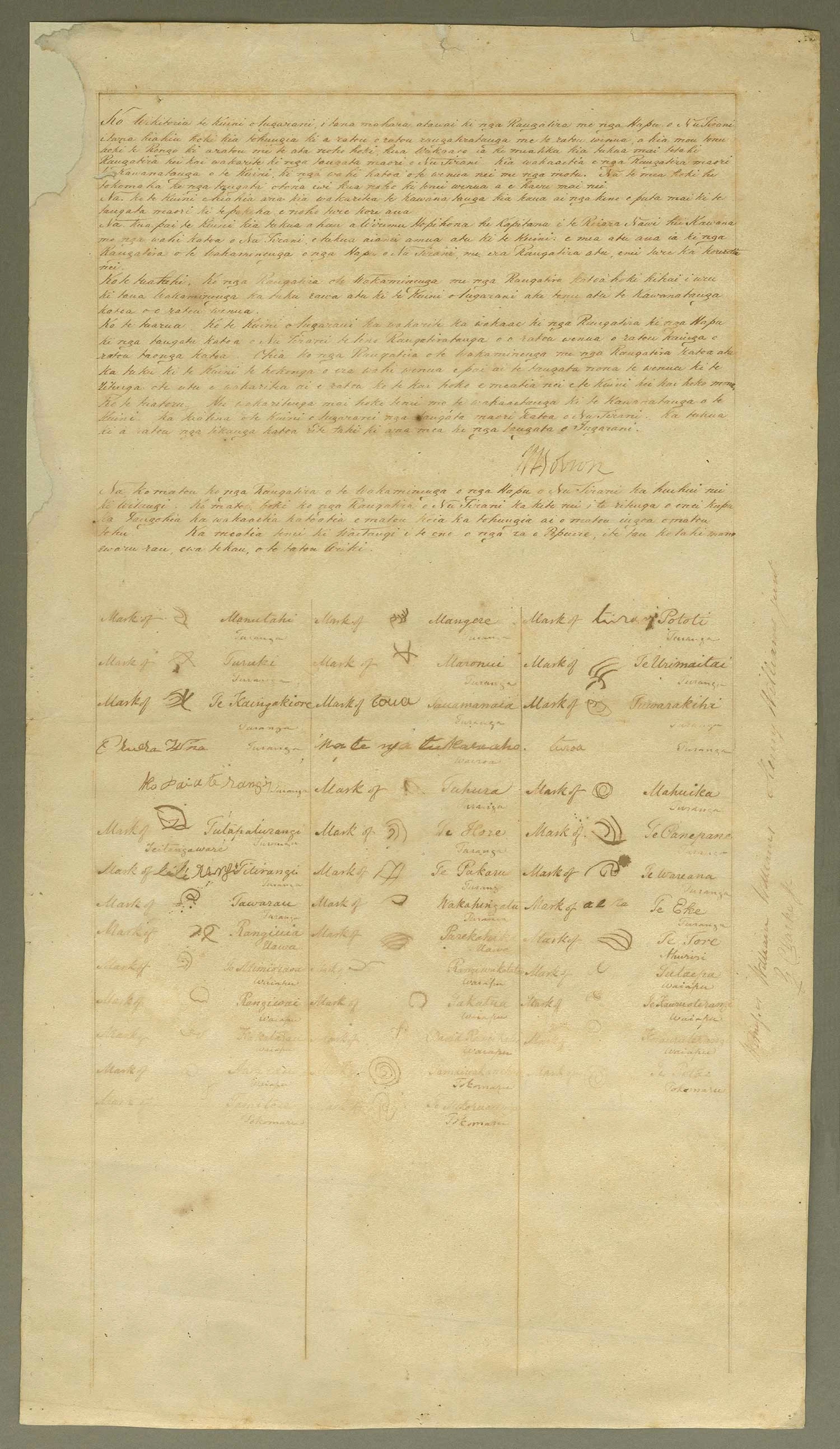
Ko te Whārangi o Te Tairāwhiti o Te Tiriti o Waitangi he ōrite te tuhituhi ki tērā i whakamahia e Henry Williams (Te Whārangi o Raukawa Moana). E rua hoki āna taitapa. He waitohu tūturu kei runga, engari he kotiti, nā Hobson, e whakaatu ana i tana oranga mai i te mate ikura roro. He mea tuhi te whārangi nei ki te reo Māori.
Tirohia, tikiake rānei te Whārangi o Te Tairāwhiti o Te Tiriti o Waitangi, kia arinui te āhua
I te 8 o Āperira 1840, ka hoatu e Henry Williams tēnei tārua o te Tiriti ki tana teina a William Williams, i noho ki te mīhana o Te Rōpū Hāhi MIhinare i tū ki Tūranga. Ko tāna mahi mā tāna teina, he kohikohi i ngā waitohu o ngā rangatira o Te Tairāwhiti tae noa ki Ahuriri.
I waenga i te 5 ki te 12 o Mei, 25 ngā rangatira o Tūranga i waitohu. E ai ki a Williams, tata tonu ko ngā rangatira katoa ēnei o te rohe. Engari i Ūawa i te 16 me te 17 o Mei, kāore rawa a Te Kani-a-Takirau, he ariki nui, i waitohu, nā reira i te hē pea te kōrero a Williams. Ko ētahi rangatira i waitohu:
E 2 i Ūawa
E 7 i Waiapu (Whakawhitirā) i te āhua 25 ki te 31 Mei
E 3 i Waiapu (Rangitukia) i te 1 o Hune
E 4 i Tokomaru i te 9 o Hune.
Ko te whakaaro o Williams, ko te kohi i ētahi atu waitohu i te tonga o Tūranga i te Hūrae, te Ākuhata rānei engari kāore i tutuki.
Ko te kaiwhakaatu i ngā waitohu o te Whārangi o Te Tairāwhiti ko William Williams, rātou ko Henry Williams Paku, ko George Clarke Paku. Hui katoa, he 41 ngā waitohu. I roto i tana reta ki a Shortland i te 8 o Mei, ko te kōrero a Williams, he "hukihuki noa iho tēnei o te Tiriti", nā reira i te tatari pea ia i tētahi whakaūnga, whakamananga rānei. Ko ia anake te mihinare i kōrero pēnei.
The East Coast Sheet of te Tiriti o Waitangi is in the same handwriting as the one used by Henry Williams (the Cook Strait Sheet). It also has a ruled double border. It has a genuine but shaky signature by Hobson, showing that he was recovering from his stroke. This sheet is written in te reo Māori.
View or download the East Coast Sheet of te Tiriti o Waitangi in high resolution
On 8 April 1840, Henry Williams delivered this copy of the Treaty to his brother William Williams, who was based at the Anglican Church Missionary Society mission in Tūranga. He tasked him with gathering the signatures of rangatira from East Cape to Ahuriri (Napier).
Between 5 and 12 May, 25 chiefs at Tūranga signed. According to Williams, this was almost the entire leadership of the district. But at Uawa (Tolaga Bay) on 16 and 17 May, prominent rangatira Te Kani a Takirau refused to sign, making this claim doubtful. Rangatira who did sign include:
2 at Uawa
7 at Waiapu (Whakawhitira) around 25 to 31 May
3 at Waiapu (Rangitukia) on 1 June
4 at Tokomaru on 9 June.
Williams planned to gather further signatures south of Tūranga in July or August, but this did not happen.
The signatures on the East Coast Sheet were witnessed by William Williams, Henry Williams Junior, and George Clarke Junior. In total there were 41. In his letter to Shortland on 8 May, Williams refers to this sheet as a "draft of [a] Treaty", indicating he expected a subsequent confirmation or ratification. He is the only missionary to suggest this.
Tirohia ā-kanohitia ngā whārangi o Te Tiriti o Waitangi
View the sheets of te Tiriti o Waitangi in person
I tua atu o te tirotiro i ngā whārangi o Te Tiriti o Waitangi ki te ipurangi, ka taea e koe te titiro ā-kanohi tonu ki He Tohu i te taha o He Whakaputanga o Te Rangatiratanga o Nu Tireni me te Petihana Mana Wāhine.
Hei wāhanga mō ā mātou mahi hei kaitiaki i ngā pūranga 7 miriona nā ngā tari kāwanatanga me ngā whakahaere tūmatanui o Aotearoa i waihanga, ka mahi mātou ki te rokiroki, ki te tiaki hoki i ngā whārangi taketake o Te Tiriti o Waitangi. Ko tō mātou whāinga, kia ngāwari noa te āhei mai o ngā tāngata katoa o Aotearoa ki tēnei taonga, me te tūhono i a koe ki ō tika me āu kōrero.
As well as viewing the sheets of the Treaty of Waitangi online, you can see them in person at He Tohu alongside the Declaration of Independence of New Zealand and the Women’s Suffrage Petition.
As part of our role as guardian of over 7 million records created by the government and public institutions of Aotearoa New Zealand, we work to preserve and protect the original sheets of te Tiriti o Waitangi. Our goal is for all New Zealanders to easily access and use this taonga, connecting you to your rights and stories.
